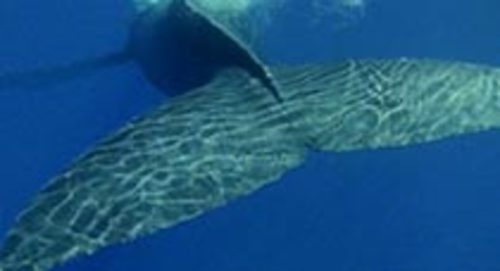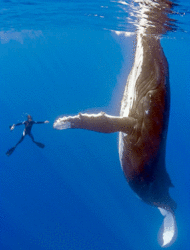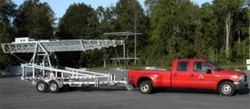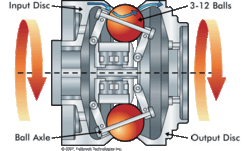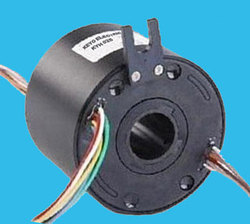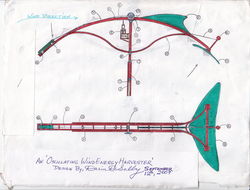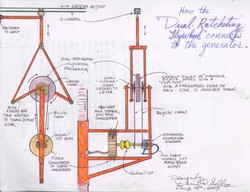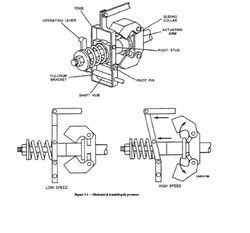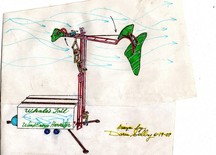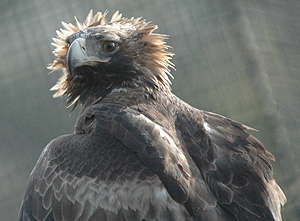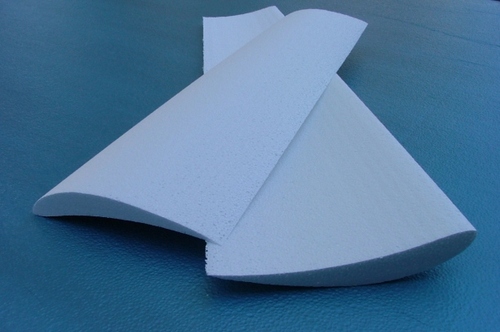The "Whale's Tail" Wind Energy Harvester
And, what's more truthful than embodying qualities seen in the tail
Of the lowly Humpback Whale?
http://www.youtube.com/watch?v=gJ0HtxkXCyA
And to explain in detail, how to oscillate a lever with a horizontal sail
People are startin to groove on this 'wave harvesting' concept!
Design factors to build it, this big creature has long secretly kept!
All living 'round it benefit, as the wind moves it to and fro.
Harvesting wind-borne energy without disrupting the flow!
Wildlife in the area is protected by something very clever.
It's quite a simple device. A big wing balanced upon a lever!
By revealing what the Humpbck whale has been doing all along.
They become our teachers guiding us, as they sing their free-energy song!
The way these great creatures move, as they gracefully power-swim,
Reveals a simple energy-transfer, at the end of a long, strong limb!
The wing rises upward then downward, just a small wind makes it start.
Humpback Whales migrate over 5100 miles!
Below is the latest, and most stable design, that's best suited for high winds. It incorporates "off-the-shelf" parts, which can be purchased online.
Comprehending and copying the flowing patterns that are seen in the Humpback Whale, makes this all possible!
Click on photo below to see this portable telescoping tower fully extended. Visualize the "Whale's Tail" oscillating at the very top!
Click on picture below to see a "NuVinci CVT" coupled with a generator
^ The tried-and-tested Ultralight Trike Wing: http://www.northwing.com/northwing-trikes-wings.htm#mustang3
It could be covered in a fiberglas/resin material to strengthen it for durability.
^ an electrical slipring assembly. Click on photo to see inner schematic diagram of this device.
Below is a simple "animation" of the Whale's Tail oscillating completely through its cycle. (Click on drawing to enlarge)
-parts description-
3)Powerline coming off of the slip ring assembly.
4)Slipring assembly
6)Aluminum pole that is of 4-6" in diameter.
7)Two sets of 4" ID needle bearings, that allow the pole to swivel
8)Dual-ratcheting flywheel, a cement-filled bicycle wheel with
15)Downwind rudder
18)Telescoping tower assembly.
26)Battery Bank counterweight which is on concave wheels (32)
27)Curved stabilizer bar, that slides freely back and forth through two concave
29)concave rollers (two on each side of the mast), that are securing
*The switching wing bracket is now wider, where the hanging ultralight
A simple hand crank-operated tilting mast. Envision the "Whale's Tail" at the top of this mast. Cranking leverage to right the mast could be even more than what is shown.
^ Click on picture above to see a drawing that depicts the trailer-mounted, telescoping tower assembly http://www.goalltech.com/products.html
-with two-360 degree swivel needle bearings, and an electrical slipring assembly
To obtain large inside diameter (ID) needle bearings:http://www.directindustry.com/prod/rbc-bearings/heavy-duty-needle-roller-bearing-16837-37388.html
-and a slipring assembly, which allows the mast to freely swivel 360 degrees, while still maintaining electrical conductivitiy to the ground. http://www.mercotac.com/html/threeconductor.html
#8 Detail Drawing ^ Up-and-down gets turned into 'round-and-'round! This shows how the "Dual Ratcheting Flywheel" assembly connects to the low rpm / high wattage 'Ginlong' electric generator. http://www.ginlong.com/en/PMG.html
This recently developed mechanism makes it even easier to turn up-and-down into 'round-and-'round!
^ Above is a basic mechanical centrifugal governor. As the power shaft rotates, weights get thrown outward, and pull on a cable, which travels out from the center of the shaft. http://www.tpub.com/content/automotiveenginemechanics/TM-9-8000/TM-9-80000196.htm
This controls the RPM speed output of the NuVinci CVT transmission.
A fail-safe "extremely high winds" system, which utilizes the combination of an anemometer & electric solenoid on the switching lever.
This would cause the Ultralight trike wing to "lock" into a parallel position, with relation to the ground. And then, in essence, aerodynamically ride-out the storm!
^ "At the world's largest wind project, Altamont Pass Wind Power Resource Area in California, between 570 and 835 raptors are killed each year by wind turbines..."
http://www.northwesternoutdoors.com/Blog/page1/2009/05/27/0b67426e-d732-4e61-a12a-5086eb6c501f.aspx
^(Click on raptor photo above, to see what other flying creature is even more endangered by windfarms! This particular animal has to only be in the downwind vicinity of the spinning blades; to then be killed by what is referred to as 'barotrauma'! It is similar to deep-sea divers coming up too quickly, & get the 'bends'.)^
< Here is the "Whale's Tail" wind energy harvester parts list.
Imagine many of these 'Whale's Tails' upon a Maui horizon, gracefully oscillating up-and-down. In future models, the shape of the oscillating wing could even mimick the actual shape of the whale's tail.
What a tribute to this species, and a 'biomimicry Maui message' to the world, it could become!
And, as you can see in the #8 detail drawing^, the up-and-down can now be easily turned into round-and-round!
Notice that the aluminum teeter-totter 'lever' is stabilized by the downward-curving of the lever.
The specially-curved lower'stabilizer pipe', that's running through a pair of 'concave rollers', protects from any potential twisting motion in high winds.
The overall appearance of the downward curved lever, and the contour of the rudder fin to look like a dorsal fin, gives a better aesthetic appearance to this design.
Comprehending and copying the flowing patterns that are seen in the Humpback Whale, makes this all possible!
'Leverage momentum' (kinetic energy) is what's stored with the oscillating motion of the curved lever! A kind of teeter-totter balancing act between the battery and the wing. As with a Grandfather Clock pendulum, so too, this is like a pendulum that's on its side!
Battery technology is rapidly evolving into making available what is referred to as an Ultra-Capacitor battery.
http://peswiki.com/index.php/Directory:EEStor
http://en.wikipedia.org/wiki/EEStor
With the slow-moving, large torque capability of the Whale's Tail, a future model may fully charge an Ultra-Capacitor battery bank, which is the counterweight to the ultralight wing, in less than half an hour!
Then, it is all telescoped back in, folded & stored. All the while, the curved lever mount stays fully attached to the end part of the mast. The curved lever itself would break down into eight fit-together pieces.
When the electrical connection is re-established, a power switch is turned on to then become the power source of an electric vehicle, which tows this Whale's Tail trailer. It travels only 25-35 mph, getting powered down the road by this process for many hours.
To go farther, by re-charging the batteries, the entire wind energy-harvesting scenario starts all over again!
^This is a 2-part Zagi Glider Wing before assembly. It'll be used for the oscillating tabletop prototype! (Click on photo to go to Zagi RC Glider website.)
A Russian scientist named, "Dr. Evgeny Sorokodum, demonstrates, with mathematical flow charts, his Russian-style "Flapping Wing Wind Generator"
and plainly states that it is 3x more efficient than its spinning propeller counterpart!
Animation
of a
"Russian Wind Generator with Flapping Wing":
(click on the link below, and then scroll all the way down to almost the bottom of the page).(Though, he doesn't reveal how he... 1)switches his wing, 2)balances the wing weight efficiently, 3)extracts energy from the oscillating motion, 4)creates the right wing shape, with the correct airfoil lifting contours, which are explained in detail here:
To learn about a new technology, called, "WhalePower", which emulates the hydrodynamics of the Humpback Whale's tubercles, that are found on the leading edge of its pectoral fins, then go here:
http://www.whalepower.com/drupal/
This genius invention of a marine scientist named, Frank Fish, has also inspired me to incorporate his discoveries as well into my drawing designs.
When the full-scale prototype of the Whale's Tail is constructed, his "tubercle technology" could be retrofitted onto the leading edge of the Ultralight wing. Perhaps it is a lightweight molded ridge, that glues in place to give a 20% increase in the wing's lifting ability.
This is the main reason why this "wind energy harvesting" concept is called the Whale's Tail, because it is literally comprehending and copying the very workings that are utilized in Nature!
In collaboration with marine biologist Frank Fish of West Chester University, in Pennsylvania, who specializes in the biomechanics of cetacean swimming,
Ted Ciamillo designed a carbon-fiber "tail" for divers, called the Lunocet. It is modeled on Frank's CAT scans of dolphin flukes, the Lunocet has a hydrofoil profile, like an underwater wing.
And after watching this video at the Lunocet website entitled "More Testing",(2nd to the last video on this page):
http://www.lunocet.com/blog/?cat=6
- I now understand the correct motion for the efficiency of the "Tail" to switch upward, and then downward.
Ted's Lunocet is the inspiration for the correct mechanical oscillating movement of the"Whale's Tail" Ultralight wing.
Their inspiring work has now spurred me on to share this completely worked-out concept...to make it a better place for all of us to live in!
Long-term use of this simple, yet very durable design, will pay for itself many times over in its superior abilities and artistic appeal.
Once a prototype is seen in action, and its superior ability in electricity-generating, it could spark a movement, and a resounding message, with its inherent creature-friendly qualities!
This new type of wind energy harvester could single-handedly make the traditional spinning-propeller wind energy generator obsolete!
We've all pretty much bought the wind farm about what has been sold to us, concerning how "green" the technology is, of mega-watt spinning wind energy generation systems!
The presently-used technology at wind farms demonstrates an almost complete disregard for the vast numbers of migrating birds & bats, which they daily interfere with!
The bats that are harmed, don't even have to come into direct contact with the spinning blades. They only need to be in the vicinity of the intense chaos of vacuum vortexes created in high winds, which then causes their little lungs to explode!
Erin Baerwald of the University of Calgary in Canada. "An atmospheric-pressure drop at wind-turbine blades is an undetectable-and potentially unforeseeable-hazard for bats, thus partially explaining the large number of bat fatalities at these specific structures.
"Given that bats are more susceptible to barotrauma than birds, and that bat fatalities at wind turbines far outnumber bird fatalities at most sites, wildlife fatalities at wind turbines are now a bat issue, not a bird issue.
The technology of spinning wind energy-production is also starting to get a foothold underwater, and is already being utilized in major river systems. This oscillating Delta wing concept could work as equally well underwater.
What are the advantages of the "Whale's Tail" over the traditional, spinning propeller windpower generator systems?
1) The 'surface contact area' of the one "Tail" wing is much greater than a comparable-sized, 3-bladed spinning windpower generator 'surface contact area' combined!
The wind blowing across the wing surface has an incredible torque-transfer through the 10:1 lever to which it is fastened. This spins a low r.p.m. generator that will give 3x the amount of electricity output!
2) Totally migratory bird and bat-friendly.
3) The system works just as well in underwater currents, without any threat to the marine life swimming past it.
4) It is artistically-beautiful to watch in motion, as it would elegantly oscillate up-and-down in the wind; emulating the graceful movement of a Humpback Whale's tail.
5) "Helicopter" sounds are completely eliminated in high winds!
6) Since no one has ever built a large, wind energy generator device such as this before, the media attention through the building a prototype would be tremendous!
7) And, lastly, as proven by recent research by the U. of Illinois,
reducing-turbulence-in-large-wind-farms
-reveals the little-known detrimental effects of wind farms, and the chaos vortices they produce downwind on the local flora of an area...up to 2 miles away!
Here is a website that reveals just what people are saying about having to live next to a spinning-propeller wind farm:
Windfarms Give False Tornado Readings:
http://www.huffingtonpost.com/2009/08/26/wind-farms-can-appear-sin_0_n_269997.html
Another windfarm band-aid fix with sonar bat deterrence:
http://www.livescience.com/animals/090721-bat-radar.html
"Holy sonar romance..."
http://www.sciencedaily.com/releases/2009/08/090825090751.htm
So, let me get this straight...
When flying downwind of a giant spinning wind power generator, bats will be killed, due to the affects of barotrauma,
-OR-
Bat communication sonar gets scrambled by the stronger windfarm repelling sonar signal. They don't mate, the bat population drastically decreases.
*****
"Wind Turbines Impact Local Weather Patterns"
http://www.sciencedaily.com/videos/2005/1012-wind_farms_impacting_weather.htm
"Recycling Turbines Must Be Taken Into Account"
http://www.sciencedaily.com/releases/2007/09/070921071653.htm
$16 Billion For New U.S. Windfarms
http://www.sciencedaily.com/releases/2009/07/090717150256.htm
I believe that even if many Whale's Tails are implemented together, in a proper "in-series" wave-catching formation, protection of the flora in a local area is assured. The intense downstream chaos vortices, created by many large propellers, are then completely eliminated.
So, as you can see, in every way, the building of many "Whale's Tail" wind generators, if they are lined up to catch the same wind wave, will beautify an area by their graceful, synchronized-oscillation motion.
A design prototype will also spark major public interest, and an awakening to what isreally going on with the so-called, present-day wind farms, and also spinning-bladed riverpower generation systems!
The results of embarking upon this vision is a long-term preservation of our wildlife, while we also receive 3x the windpower/waterpower energy-harvesting abilities than before!
